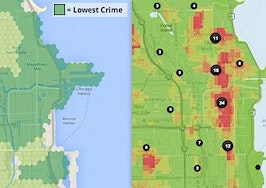- A new index shows the local concentration of registered criminal offenders, which usually reflects only registered sex offenders, but may also include other types of offenders.
- RealtyTrac, which has created the index, plans to integrate it into Home Disclosure and Homefacts.com.
- ZIP codes with high concentrations of offenders tend to have low home values and high foreclosure rates, though the connection between offender density and home appreciation rates is more nuanced, RealtyTrac found.
You might expect people researching properties and neighborhoods to be most interested in learning about local home values, schools, foreclosures or environmental hazards.
But folks tend to focus most on another type of information, at least when it’s available: the identities and locations of local sex offenders.
That’s what RealtyTrac has discovered, having observed the behavior of users of neighborhood data website Homefacts.com and property report provider Home Disclosure, both of which are operated by RealtyTrac.
That finding has inspired RealtyTrac to release the “Home Disclosure Registered Criminal Offender Index,” which measures the local concentration of sex offenders — and in some states, other sorts of violent offenders as well.
RealtyTrac plans to complement the crime rates and existing sex offender data on HomeFacts.com and in HomeDisclosure reports with the index, which would mark the latest type of sensitive data to be mixed into online real estate search. The index may provide consumers with a better feel for neighborhoods, but it could also cause some headaches for agents.
“I would say most buyers or many buyers would want to know about this information and so being aware of that as a buyer’s agent and getting ahead of that would be a good thing,” said Daren Blomquist, vice president of RealtyTrac.
Agents might want to avoid being “surprised by buyers who are looking at this information and factoring it into their decisions,” he added.

Screen shot showing the sex offender section of a sample Home Disclosure report. RealtyTrac’s offender index is set to be added into the report to provide perspective on the prevalence of registered offenders.
RealtyTrac introduced the offender index in a report revealing that high concentrations of offenders correspond with low home values and high foreclosure rates. Its conclusions about the connection between offender concentration and home value appreciation was more nuanced, however.
Registered offenders can mean different things in different states
The index is based on the number of registered criminal offenders as a percentage of the total population in a ZIP code.
The index ranges from 0 to 100, with a higher index indicating a higher percentage of offenders. It covers 10,000 ZIP codes and will be featured in a report on at least a quarterly basis.
You can get local offender indexes by contacting RealtyTrac at marketing@realtytrac.com, or calling the firm’s toll-free number 877-888-8722 and pressing option 1 for real estate agents.
In most states, only the local density of registered sex offenders is measured by the index. But in some states, the index reflects not only the local concentration of sex offenders, but also the concentration of offender types, including “child predators,” “kidnappers,” “criminals,” “kidnappers,” and “child kidnappers.”
That means apples-to-apples comparisons between ZIP codes in some states and ZIP codes in other states aren’t possible. But such comparisons can always can be made between ZIP codes in the same state.
The variance in classification of registered offenders measured by the index “is a challenge with this index,” and reflects RealtyTrac’s decision to incorporate “any criminal offender that a state deems should be registered and that registration open to the public,” Blomquist said.

Chart shows what criminal classifications are reflected in RealtyTrac’s criminal index by state.
Integration into Home Disclosure and Homefacts.com
The index will be woven into RealtyTrac’s Home Disclosure, one of a growing number of providers of detailed property reports.
Home Disclosure reports include the locations of nearby sex offenders, crime level, school quality, median income, racial makeup, loan and equity information, “fair market rent” and nearby fire stations.
“Some of the feedback we get, honestly, is that it’s fairly hard to find a property without any sex offenders [nearby], especially within one mile; it’s just very, very common to see that,” Blomquist said.
That’s why the offender index will add value to Home Disclosure reports, Blomquist said. It will contextualize the other offender data, showing prospective homebuyers whether the amount of nearby sex offenders is more or less than normal, he said.
RealtyTrac also plans to surface the index on Homefacts.com, which provides some of the same data as Home Disclosure for neighborhoods and properties.
RealtyTrac hasn’t decided how exactly it will incorporate the firm’s offender index into Home Disclosure or Homefacts.com, said Mike Sawtell, general manager of consumer solutions at RealtyTrac.

Homefacts.com property pages includes ‘registered offenders’ notice up top. Offenders locations and identities are revealed further down on each page. RealtyTrac’s offender index is set to surface on Homefacts.com.
‘Following all the rules’
Sawtell did say that, in the interest of “following all the rules,” the index won’t show up on for-sale listings that are searchable on Homefacts.com.
RealtyTrac learned those rules the hard way in the spring of 2014.
The firm added sex offender data to for-sale listings on realtytrac.com at that time only to remove that data — along with other types of neighborhood data — not long after.
Today, visitors can only view certain information, including sex offender data, for for-sale listings on realtytrac.com or Homefacts.com by clicking to view a “complete property report” on listing pages. The tab brings a visitor to a separate property page featuring the data, but not any MLS data.
It’s easy to understand why MLSs and real estate agents might disapprove of sprinkling offender data onto listing pages: it has the potential to scare off prospective buyers.
Some housing observers also worry that intermingling sensitive data with online real estate search tools could ultimately serve to aggravate disparities between communities.
That may be a stretch for Blomquist, but he did say that “exposing this type of information more conveniently and more transparently could affect certainly decisions and markets.”
Another concern with offender data is that it can be inaccurate or outdated. Offenders may not immediately register their new addresses when they move, or for that matter, register them at all.
RealtyTrac mitigates the first risk by updating its offender data — which Blomquist said RealtyTrac assembles from state offender registries using a “proprietary data aggregation strategy” — every two weeks. But the firm can’t address the second risk.
How agents should handle sex offender information
Buyer’s agents often should share certain sex offender information with buyers in states where it’s permitted, according to guidance from NAR and real estate attorneys. That generally means not only providing notice to buyers of where they can find sex offender information but also sharing any actual knowledge of offenders living close to listings of interest to buyers, NAR and attorneys say.
In addition to disclosing actual knowledge of sex offenders, buyer’s agents should also consider revealing information they may have come across on a state sex offender registry that might be relevant to a client — as long as they cite the registry as the source of the information.
That’s not to say that buyer’s agents are legally obligated to dig up sex offender information for buyers. They are not, NAR and attorneys say. Any responsibility agents may have to share sex offender information, sources say, ends after they have disclosed only what they already happen to know.
It remains to be seen whether sex offender data may find its way onto other real estate search sites. But given that RealtyTrac is a provider of neighborhood data to many listing search sites, that prospect is more plausible than ever.
Some listing portals, which Blomquist said he couldn’t name, have expressed interest in Home Disclosure reports, he said.
Connections between offender index and housing markets
RealtyTrac’s report on its offender index found that average home values and home equity in 2015 were lower in ZIP codes with a higher offender index (ZIP codes with a higher concentration of offenders). Meanwhile, average foreclosure rates in 2015 were higher in ZIP codes with a higher offender index.
Blomquist said in a statement that this provides “concrete evidence that registered criminal offenders pose not only a potential safety risk for homeowners and their families, but also a potential financial risk for what is likely a homeowner’s biggest asset.”
But that may be a bit of an oversimplification.

Source: RealtyTrac
The referenced “financial risk” is mostly corroborated by the correlation between high foreclosure rates and high offender concentrations, Blomquist said. That’s because foreclosures can chip away at the quality of life in a neighborhood — they often aren’t maintained and can portend crime, he said.
However, another common effect of high foreclosure activity, downward pressure on home values, apparently hasn’t taken hold in areas with high concentrations of offenders, at least in the last five years, according to RealtyTrac’s analysis.
Home values have actually increased at a faster rate over the last five years in ZIP codes with a higher offender index, RealtyTrac found.
“You could potentially argue that somebody who’s owning for just one to five years, you’re either fine or actually even better off financially if you’re buying in a market with a higher sex offender index,” Blomquist said.
It’s only when you look at home appreciation rates over a longer timeline that living near sex offenders appears to negatively affect home value appreciation. Home values in the “lowest-risk” ZIP codes for offenders tended to rise at a faster rate than those with higher concentrations of offenders from 2005 to 2010, according to RealtyTrac.
Ranking markets by sex offender concentration
RealtyTrac released rankings for markets with the highest percentage of homes in ZIP codes with a very high offender index and the highest percentage of homes in ZIP codes with a very low offender index.
ZIP codes were placed in one of five risk categories, each representing 20 percent of all ZIP codes: very high, high, medium, low and very low.
Markets with the highest percentage of homes in ZIP codes with a very high offender index were Greenville, South Carolina (73 percent); Columbia, South Carolina (66 percent); Boise, Idaho (66 percent); Pensacola, Florida (60 percent); and Flint, Michigan (57 percent).
Major markets where more than one-fourth of all homes were in ZIP codes with a very high offender index included Detroit (39 percent), Nashville (32 percent), San Antonio (31 percent), St. Louis (31 percent), and Tampa (26 percent).
Markets with the highest percentage of homes in ZIP codes with a very low offender index were Minneapolis-St. Paul (90 percent); Portland, Oregon (88 percent); Trenton, New Jersey (62 percent); New York (61 percent); and Boston (52 percent).
Other major markets where more than one-fourth of all homes were in ZIP codes with a very low offender index included Phoenix (47 percent), San Francisco (38 percent), Seattle (36 percent), San Diego (35 percent), Miami (29 percent), Los Angeles (29 percent) and Chicago (29 percent).
If you want to learn about connections between RealtyTrac’s offender index and home values, home equity and foreclosure rates, see RealtyTrac’s full report.









